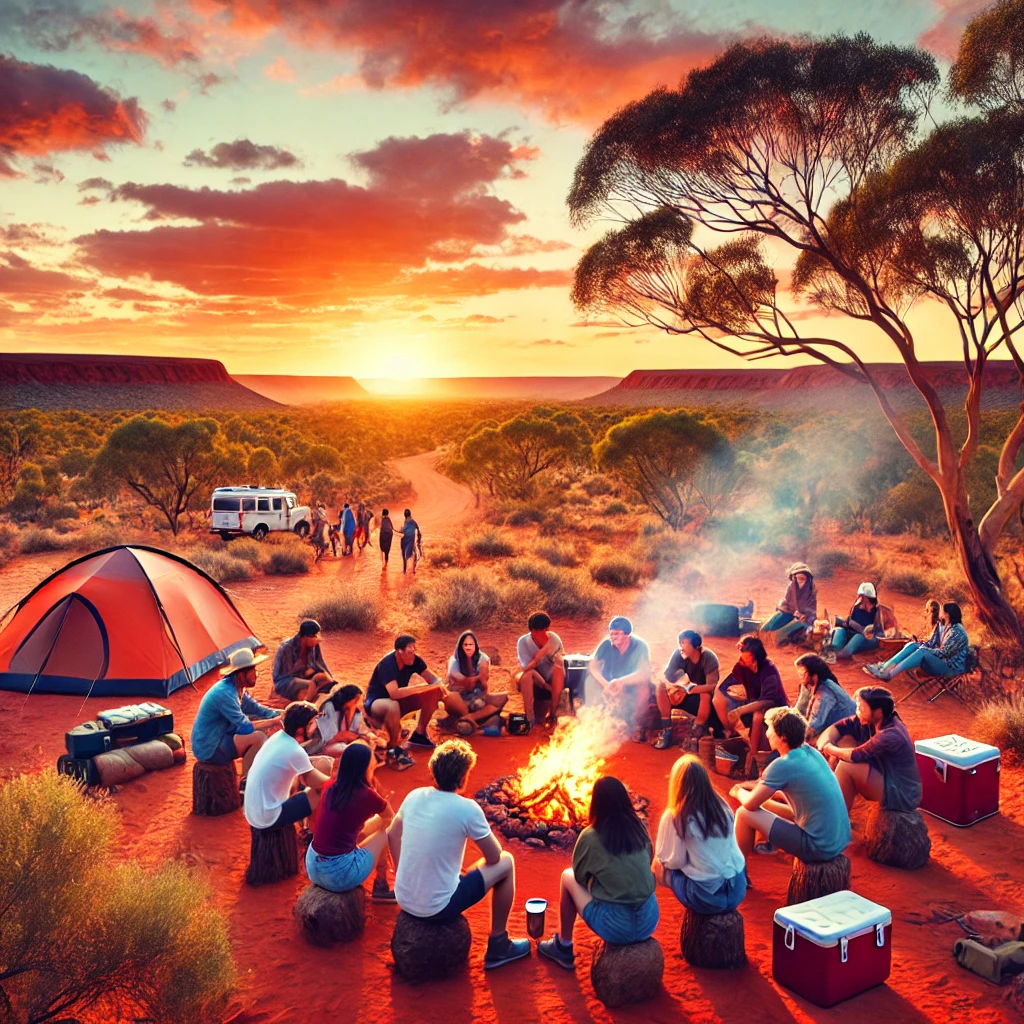Table of Contents

Introduction to Camping in the Outback
The allure of the Australian Outback offers a unique and transformative experience for camping enthusiasts. This vast and rugged terrain showcases breathtaking landscapes, from sunburnt deserts and dramatic red rock formations to vibrant bushlands and lush riverbeds. The expansive views provide a sense of freedom, allowing adventurers to wander through untouched wilderness while encountering the diverse wildlife that calls this region home.
Camping in the Aussie bush can be both exhilarating and humbling. The Outback is renowned for its rich habitats that support a variety of species, including kangaroos, emus, and countless bird species. Nature lovers have an exceptional opportunity to observe these animals in their natural setting, fostering a deeper connection to the environment. Each night spent under the stars enhances this experience, as the clear skies reveal a stunning canopy of constellations that are often hidden in urban areas.
However, the thrill of an Aussie bush camping adventure does not come without its challenges. Proper preparation is paramount to ensure a rewarding experience. Understanding the climate, navigation skills, and knowing what supplies to bring can significantly impact the overall enjoyment of your trip. It is essential to plan for unexpected weather conditions and ensure that your camping gear is suited for the Outback environment.
In addition to logistical planning, familiarize yourself with local wildlife and the importance of conservation efforts. Respecting the natural habitat and adhering to responsible camping practices contribute to the sustainability of these magnificent landscapes. With the right preparations and a spirit of adventure, camping in the Outback can be a truly unforgettable journey into the heart of Australia.
Choosing the Right Campsite
When planning an adventure in the Aussie bush, selecting the right campsite is crucial for ensuring a memorable and enjoyable experience. The Outback offers diverse terrain and unique environments, making it essential to consider several factors when choosing your ideal spot.
Proximity to water is one of the primary considerations. Many campsites near rivers or lakes provide natural beauty and recreational opportunities such as fishing or swimming. However, be cautious; campsites adjacent to water can attract wildlife, which may pose safety risks. Therefore, research campsites that strike a balance between beauty and safety.
Access to trails is another important aspect to consider. Campers often seek trails for hiking, biking, or exploring the surrounding area. Selecting a campsite that offers easy access to these paths enhances your overall experience in the bush, allowing you to immerse yourself in the stunning landscapes of the Outback. Renowned locations like the Grampians National Park and Kakadu National Park boast a variety of well-marked trails for varying skill levels.
Safety from wildlife is also paramount. The Aussie bush is home to diverse wildlife, including snakes, spiders, and large mammals. Choosing a campsite that minimizes exposure to these creatures is advisable; open areas with clear visibility are preferable. Additionally, consider sites that provide facilities such as fencing or designated fire pits to deter animals.
Lastly, weigh your preferences regarding solitude versus community. Some campers may enjoy the camaraderie found in popular campsites, while others may prefer the peace and quiet of less-traveled areas. Hidden gems, such as Nullarbor Plain and remote spots along the Murray River, offer opportunities to connect with nature away from crowded areas. Ultimately, your choice of campsite will set the stage for a remarkable Aussie bush adventure under the vast Australian sky.
Essential Camping Gear and Supplies
Embarking on an adventure into the Aussie bush requires careful consideration of essential camping gear and supplies to enhance your experience while ensuring safety and comfort. Proper preparation is vital for navigating the rugged and unpredictable terrain of the Outback.
Starting with shelter, selecting a suitable tent is crucial. Opt for a lightweight, durable tent designed for varying weather conditions. Make sure it’s easy to set up and provides enough space for your group. Additionally, a high-quality sleeping bag and sleeping pad will ensure a comfortable night’s sleep, while also providing insulation from the cold ground.
Next, consider your cooking equipment. Portable stoves or camping grills are essential for meal preparation. Pack lightweight cookware such as pots, pans, and utensils, and don’t forget a reliable water filter or purification tablets to stay hydrated. Having a compact cooler can help preserve food for longer trips, while non-perishable items, such as canned goods and dehydrated meals, minimize weight and maximize convenience.
Appropriate clothing is another category that merits attention. Since the weather in the Aussie bush can vary greatly, layering is recommended. Invest in moisture-wicking base layers, insulated mid-layers, and waterproof outer layers. Comfortable, sturdy footwear is vital for hiking and exploring, along with sun protection items such as hats and sunglasses.
Safety gear cannot be overlooked. A well-stocked first-aid kit is essential in case of minor injuries or ailments while camping. Include items such as adhesive bandages, antiseptic wipes, and insect repellent. Additionally, packing a multi-tool can provide various functions, enhancing your ability to respond to unexpected situations.
When packing for your camping adventure in the Aussie bush, efficiency is key. Utilize compression sacks, zippered bags, or bins to organize your items and reduce bulk. Prioritize lightweight gear that doesn’t compromise quality, as this will make your journey more enjoyable.
Wildlife Encounters: What to Expect
Camping in the Aussie bush offers an unparalleled opportunity to witness a diverse range of wildlife in their natural habitat. From kangaroos grazing in open fields to colorful cockatoos perched in trees, the Outback reveals a unique ecosystem teeming with life. Early risers are often rewarded with the chance to observe these creatures in their most active state at dawn and dusk, making it an ideal time for nature enthusiasts and photographers alike.
While the allure of wildlife encounters is undeniable, it is essential to approach these experiences with respect and mindfulness. Keeping a safe distance from animals is crucial, as many species can exhibit unpredictable behavior when approached too closely. Observing wildlife from afar not only ensures your safety but also minimizes stress on the animals, allowing them to maintain their natural behaviors. To capture these moments, a good pair of binoculars can be invaluable, giving you a close view without intruding into their space.
When camping in the bush, awareness of potential dangers is important. Australia is home to various snakes and spiders, and it is wise to educate yourself about the species you may encounter. Always wear sturdy boots and remain vigilant when walking through tall grass or rocky areas. In the unlikely event of a snake bite, knowing the first aid procedure is essential. Larger mammals, such as dingoes, are typically shy but can become bold in search of food. Storing food securely and refraining from feeding wildlife helps maintain a respectful distance and ensures animal safety.
Experienced campers often share stories of unexpected wildlife encounters, emphasizing the thrill of witnessing these animals in the wild. Such experiences lend to the unparalleled charm of camping in the Aussie bush, making it a cherished adventure for nature lovers. Remember, a responsible approach to wildlife viewing not only enhances your camping experience but also preserves the delicate balance of the Outback’s ecosystem.
Embracing Aboriginal Culture
When embarking on a camping adventure in the Aussie bush, it is vital to acknowledge the deep-rooted cultural significance of Aboriginal heritage in the Australian Outback. Aboriginal culture, with its rich traditions and history, is intrinsically linked to the land. This connection is not merely a sentiment but a complex web of beliefs, stories, and practices that underscore the intimate relationship Indigenous Australians have with their environment.
Cultural practices such as storytelling, art, and music play a crucial role in transmitting knowledge and maintaining connections to the land. The Dreamtime, a fundamental aspect of Aboriginal spirituality, encapsulates the creation of the world and the establishment of the natural order, providing a profound context for one’s camping experience. As you explore the Aussie bush, take the opportunity to engage with the stories embedded in the landscapes and remember that each rock, river, and tree may hold cultural significance.
Respecting Indigenous sites is paramount for responsible camping. Many sites of cultural importance are sacred, and it is essential for campers to recognize and honor the protocols associated with these places. Prior to setting out, it is advisable to research significant landmarks and to adhere to guidelines set forth by local Aboriginal communities. Additionally, it is encouraged to seek out opportunities to engage with those communities, whether through guided tours, cultural workshops, or community events.
By participating in cultural exchange and showing respect for Aboriginal traditions, campers can foster an enriching connection not only to the land but also to the rich tapestry of history that defines the Aussie bush. Engaging responsibly with Aboriginal culture enhances the overall camping experience, making it both memorable and enlightening, while ensuring that Indigenous rights and stories are honored and preserved.
Navigating the Outback: Maps and Tech Tips
When embarking on a camping adventure in the Aussie bush, effective navigation is crucial for ensuring both safety and enjoyment. The Outback is known for its vast and sometimes challenging terrain, which can make navigation a daunting task for even the most experienced campers. Utilizing both traditional maps and modern technology like GPS apps can help adventurers traverse this unique environment.
While GPS technology has revolutionized navigation, it is essential to keep in mind that relying solely on electronic devices can be risky. Mobile signals may be weak or non-existent in remote areas of the Outback, making it imperative to carry a physical map. Learning to read and interpret topographic maps is a valuable skill that can enhance any camping experience, particularly in the Aussie bush, where landmarks may be sparse and unreliable.
Before venturing into the Outback, make sure to download maps that can be accessed offline. Many GPS apps, such as Gaia GPS or Maps.me, allow users to download specific areas for offline use. This feature is invaluable for navigating uncharted regions. Additionally, understanding the basic principles of navigation, such as using a compass and familiarizing oneself with local flora and fauna, can significantly improve your ability to find your way in the bush.
Weather patterns can also impact navigation in the Outback. It is essential to keep updated on forecasts and be prepared for sudden changes. A sudden storm can obscure trails and landmarks, potentially complicating your route. Making sure you have a reliable weather app or a portable weather radio can be integral for planning your camping journey. By blending traditional navigation methods with modern technology, campers can ensure a safer and more enriching experience while exploring the stunning landscapes of the Aussie bush.
Safety and Preparedness in the Outback
Camping in the Aussie bush offers an unparalleled opportunity to connect with nature, but it also necessitates a well-thought-out approach to safety and preparedness. As remote areas often lack immediate access to emergency services, having a robust safety plan is essential for any camping trip. Experts recommend preparing for various scenarios, including weather changes and potential wildlife encounters. An effective emergency plan might include designated meeting points, a first-aid kit, and a contingency plan that details how to seek help if needed.
Staying hydrated is another crucial aspect of safety while camping in the Outback. The dry Australian climate can lead to dehydration quicker than one might expect, especially during physical activities. It is advisable to drink water regularly, even when not feeling thirsty, and to carry sufficient water supplies for the entire trip. A general guideline is to aim for at least two liters of water per day per person, factoring in increased intake during hotter days or while engaging in strenuous activities.
Additionally, sunburn can be a significant risk for those camping in the bush. The Australian sun is particularly harsh, making it vital to employ protective measures. Wearing long-sleeved clothing, a wide-brimmed hat, and high-SPF sunscreen can protect against sun exposure. Setting up camp in shaded areas during peak sunlight hours can further minimize risks.
Before heading into the Outback, it is also crucial to inform someone about your itinerary. Whether it’s a friend, family member, or park ranger, this communication ensures that someone is aware of your plans and can alert authorities if you do not return as expected. By embracing these safety measures, campers can better enjoy their experience in the vast and beautiful Aussie bush while minimizing potential hazards.
Cooking and Dining in the Bush
When embarking on an adventure in the Aussie bush, one of the delights of camping is the opportunity to enjoy outdoor cooking. The experience of preparing meals under the vast sky, surrounded by nature, is unmatched and adds a unique element to your camping experience. However, to truly embrace the beauty of the bush, some planning and creativity in meal preparation are essential.
For those new to camping, simplicity is key. Choose nutritious meal options that require minimal equipment. A portable camp stove or a simple campfire can serve as your primary cooking method. One popular cooking method in the bush is using foil packets, where you can wrap diced vegetables, protein, and seasonings together and place them directly on the campfire coals. This method not only simplifies clean-up but also enhances the flavors as the ingredients steam in their own juices.
Consider preparing meals that can be pre-cooked at home and then easily reheated on your camping trip. Chili, stews, and pasta dishes can hold up well and taste even better after a day spent outside. Two easy and nutritious meal ideas include a quinoa salad, which can be made ahead of time and eaten cold, and a one-pot pasta dish that requires minimal pots and pans. With these options, you can enjoy hearty meals after a long day of exploring the Aussie bush.
Embrace the joys of the great outdoors by sharing meals around the campfire with friends and family. The crackling of the fire and the starlit sky create an unforgettable dining atmosphere. Furthermore, outdoor cooking encourages camaraderie and connection, making it a memorable part of your camping journey. No matter where your adventures in the bush take you, the experience of cooking and dining outdoors will enhance your appreciation for nature and nurture a sense of adventure.
Best Time to Camp in the Outback
Camping in the Aussie bush offers a unique experience influenced significantly by seasonal variations and regional climates. The Outback experiences distinct seasons, essentially categorized into summer, autumn, winter, and spring. Understanding these seasonal nuances is crucial for planning a comfortable camping trip.
Summer, from December to February, brings high temperatures that can soar above 40°C (104°F). The intense heat levels, coupled with a possibility of thunderstorms, can make camping uncomfortable. Thus, for those wishing to explore the finer details of Australia’s bush scenery, it is often advisable to avoid this period unless one’s camping setup includes adequate shade and cooling provisions.
Autumn (March to May) serves as a transitional period with milder temperatures and reduced humidity. It’s a favourable time for camping, with temperatures averaging between 20°C to 30°C (68°F to 86°F). Many campers find the conditions pleasant, making it suitable for various outdoor activities, from hiking to stargazing. Additionally, fewer tourists traverse the bush during this period, allowing for a more authentic connection with nature.
Winter (June to August), while cooler, can still present excellent camping opportunities. Regions within the Outback, particularly those with arid climates, experience daytime temperatures ranging from 15°C to 25°C (59°F to 77°F). Nights can be chilly, so it’s important to prepare with appropriate sleeping gear. It is worth noting that winter is a quieter time for tourism, enabling a more peaceful camping experience amidst the Aussie bush.
Spring (September to November) marks the blooming of wildflowers and is another ideal time to camp in the Outback. With temperatures rising to comfortable levels, this season allows for vibrant exploration of the landscape, making it perfect for those who wish to immerse themselves in nature’s palette. Given these considerations, determining the best time to camp in the Outback significantly depends on one’s personal preferences and tolerance to climatic conditions.






